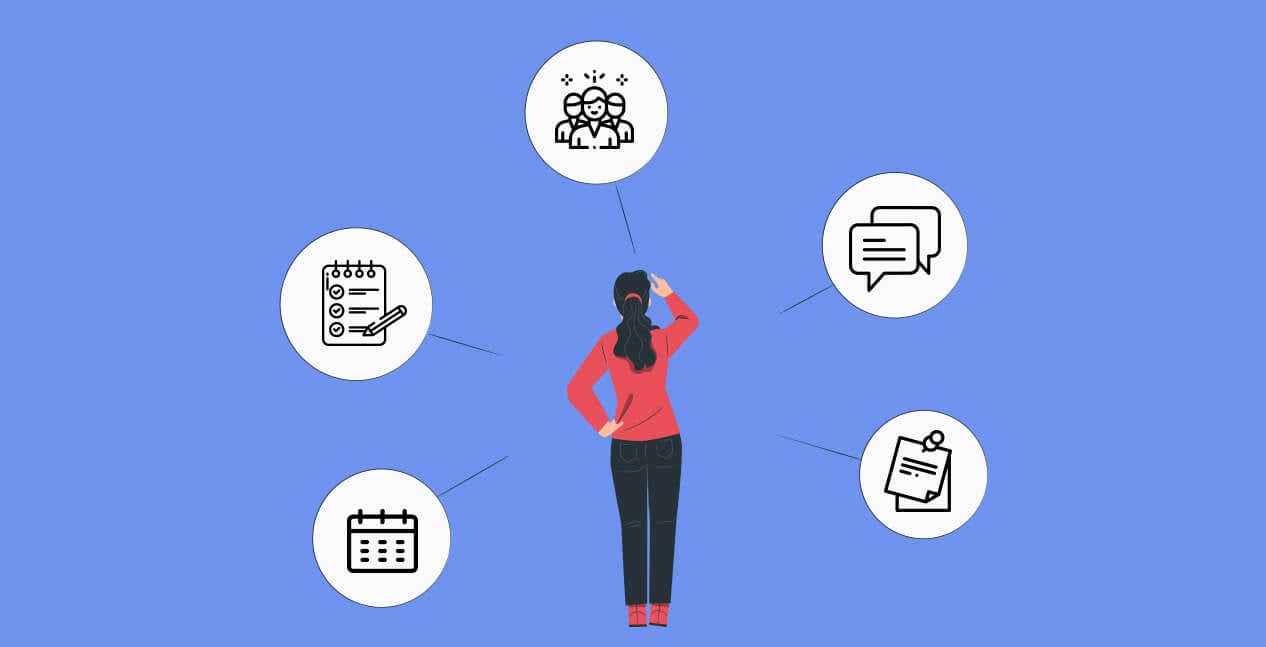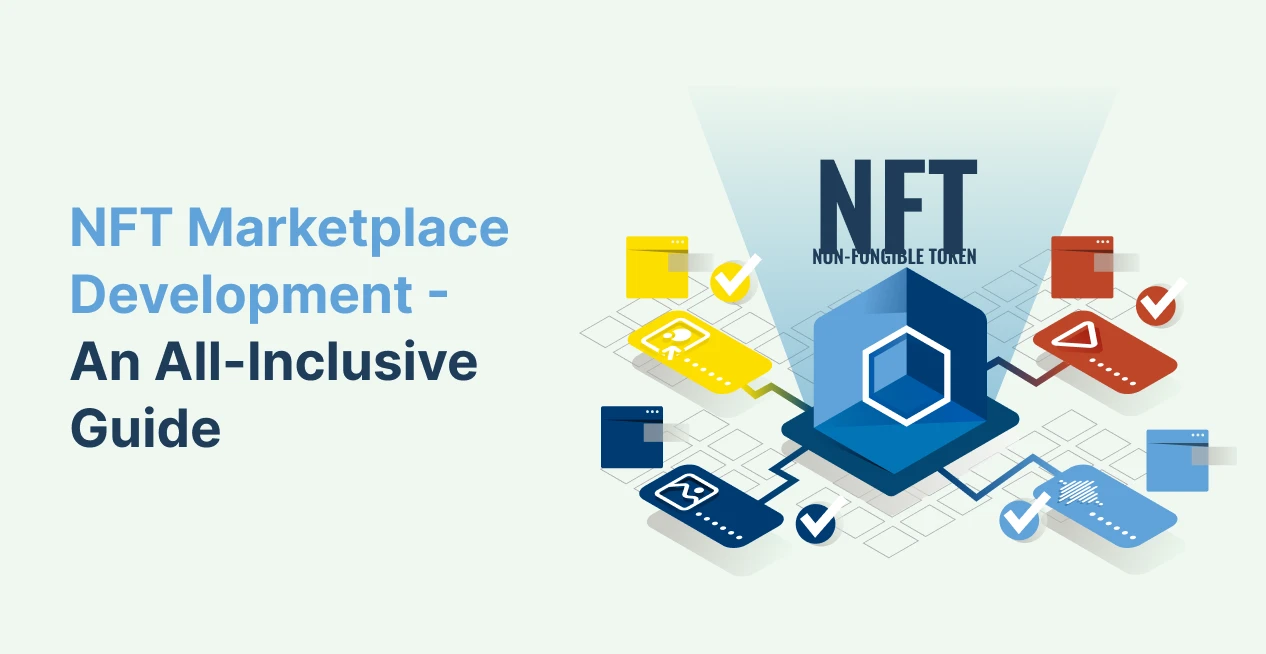In the era we live in, options are given to us in hoards. Thus it is important for a service provider to always stay up to date with the wants and needs of the customer. In the quest of understanding the thoughts of a customer on a particular product, in this case, a mobile application, user interviews can be of great help. The user interview is basically a UX method in which the individual is asked a set of questions to figure out what he perceives of the application.
User interviews can be used in Lean and Agile Methodologies which accelerates and simplifies the process. They are not only similar to the journalistic interviews but also have similarities with the critical incident technique.
These user interviews help us understand what the user thinks about the application with precision. They can specify what people think about the app and exactly at which point the app can be improved. The nature of the interviews is such that the interview can be conducted at multiple stages like pre-design or in the contextual portions or at the end to check the usability of the application.
User interview is a method that is being used most extensively in research. It covers almost all user topics, including gathering information on the user’s sentiments, how the user is using the app, what new features can be added, etc.
The interviews may be held over call or video, or it can also be conducted in the user’s home where app designers can directly pay a visit. Many interview methods have been shared with other fields, while some have been made explicitly for particular situations.
User Interview Questions:
For an interview to work properly it is of utmost importance that the interviewer and the interviewee reach a certain level of comfort where both can indulge in free discussion. That being said it is also important that there is a template to prevent the discussion from going astray or off-topic.
The user interview template for questions are categorized below:
Open Discovery Questions
A good conversation starter or carrier are open questions. These questions usually require more than one word as answers. Examples include;
- Please describe your experience while using the mobile application.
- Let’s discuss what problems you faced with the application.
- What would you like to add to the application?
- Why do you like using this application?
Understanding the tasks of the user
These types of questions are asked to understand how the task is performed. Problems that can be asked are:
Read This: Software Development Life Cycle
- Can you explain how the mobile application works?
- The process of the work of the application.
Showing or Performing
Apart from questions, the interviews may also include tasks such as:
To show the process…
- Diagramatic representation of the process of workflow of the mobile application.
- Roleplays
Understanding the past and the future
This may include asking questions about the past. Example:
- Can you remember a scenario…
- Can you explain the memory…
Opinions and points of views
These questions include opinions, but there is a high possibility that they may consist of biases.
- What do you think about it…
- What are your opinions on…
- What is your opinion on…
Talking about the problems faced
It understands the problems faced by the user and tries to resolve them.
These may include:
- How did the problem impact you?
- How did you solve the problem?
- If you could, what would you change?
How to conduct user interviews for mobile app development?
There are usually three steps while conducting a user interview for mobile application development. These include to-dos before, during, and after the interview. The steps are listed below:
Step1: Preparation before the interview
Conducting an interview is sometimes like having a conversation but with significant preparation. Thus the steps that can be followed before an interview are:
- To have a specified clear goal.
It is important to have a clear picture about the aim that has to be achieved after the interview. Sometimes during the interview there are chances especially in unstructured interviews that the discussion goes off-topic. Thus to avoid such scenarios having a clear goal is an important criteria.
- To curate an interview with respect to the problem that has to be solved and to design the interview questions accordingly:
As stated above to ensure that the interview doesn’t go off topic a set of guided questions can be formed. This basically constitutes in the domain of semi-structured interviews where the user can have a free conversation but guided in a specified route.
- To create a fair and comfortable environment.
- It is best not to conduct the interview alone.
It is always better to have an interviewer along with other team members. This becomes especially useful when the user showers information and that information has to be collected. The helpers can take notes of the same for later when everything has to be analyzed.
Read This: Find investors for your mobile app development idea.
Step 2: Steps during the interview
During the interview, it is very important to make the user comfortable. This can be done by calling up the user before so that they are accustomed to the interviewer. Being empathetic also works in increasing the level of comfort. Asking related questions can help in building rapport between the group. Apart from these certain guidelines specifically for the interviewer may be followed:
- Get comfortable in the mood.
- Follow the semi-structured interview format.
- Be friendly with the interviewee.
- Start with more straightforward questions.
- Keep the questions more open-ended.
- Ask follow-up questions.
- Clarify whenever required
- End with a wrap-up summary
Step 3: Analyzing after the interview
After the interview, the interviewer is left with large amounts of qualitative information. It is, for this reason, more people were suggested so that no piece of data is lost. The huge amount of data also calls for effective ways of collecting them. Different tools can be used for data collection and have been listed below. However, after the data is collected, it is time for analyzing them. But before the tedious process of data analysis, it is important to:
- Conduct a retrospective process
- Structure of the acquired information
How to analyze User Interviews?
The analysis of data is usually too time-consuming. The most common way of analyzing information is by thematic analysis. It identifies the patterns of themes from the collected data.
Read This: 101 Mobile App Ideas for startups in 2021
Thematic analysis is a flexible method and can be used for both discovery interviews. There is no clear set picture of what might be found out and for validation interviews where the pre-existing data must be validated.
The steps in the thematic analysis are:
- To review the notes
- To summarise the key points found from the notes in the form of small codes.11
- Categorize these codes
- Group the codes according to the similarities. From these categories of similar principles, try to find out the specific themes.
- Define the theme
- Review the theme
- Share them
Types of User interviews
The different types of user interviews are:
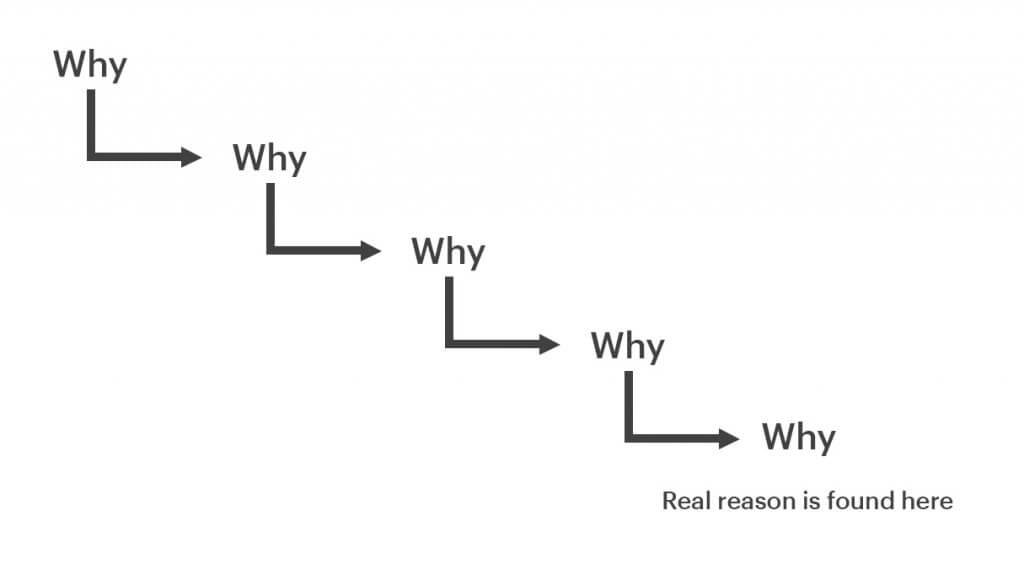
Structured Interviews
- Structured interviews, as the name suggests, has a specified structure and is the same for every user. It is used to control the type of response obtained from the user. The questions used are also mainly closed-ended.
- Structured interviews are faster and cheaper and thus are helpful for more participants.
- In structured interviews, there is very little or no place for an explanation. Thus structured interviews are best at the end of a project.
Semi-Structured Interviews
- Semi-structured interviews a little bit of structure but has a lot of opportunities for meaningful discussion. The researcher comes up with a guide for a conversation that leads the discussion in the specified and desirable direction.
- Semi-structured interviews leave room for a lot of explanation. It also creates an environment for a lot of to and fro communication between the participant and the researcher, creating a healthy relationship.
- On the contrary, this kind of communication may have a lack of control over the results found.
- Thus semi-structured interviews are more suitable for situations where the team is familiar with the user’s persona.
Unstructured Interviews
- In unstructured interviews, there are no guidelines; instead, the questions are very open-ended. This helps the user to carry on with the conversation.
- Unstructured interviews help to gather a considerable amount of qualitative data. It helps to figure out the pain points and problem areas and solve them.
- But the researcher also has to be extremely careful that the questions do not create bias in the user’s mind and are not influenced. Because of the open-ended form of conversation, there is no control over the type of information obtained.
- Unstructured interviews are thus the most helpful at the beginning of the project.
User Interview Tips
While conducting a user interview it is important to keep a track of the things we don’t want to do. These are generally categorized under the tips of the user interview. Some of the common tips are:
Read This: Mobile App Development Cost 2021
- Do not ask leading questions: leading questions are the type where the answer is already present in the question. This leads the user to give a specific type of answer.
- It is not smart to ask the user what they want because the software development team may not always be equipped with the tools to fulfill the desires. This creates dissatisfaction in the mind of the user.
- Asking close ended questions leads to answers like yes and no which creates a barrier for the
- Closed-ended questions with answers yes/no shouldn’t be asked as this creates a barrier for the real thoughts of the user to be portrayed. Thus open ended questions are always desirable.
- Stupid questions are welcome, but assumptions are not.
- Have a set of questions ready that can be used every time. These questions can be introductory questions which helps in comforting the user and getting him acquainted with the process.
- Same questions can be asked from different angles. The user can be asked :
“Does he like a particular feature in the application?” Again he can also be asked “Does the feature help him to make his life easier?”
- Follow up questions should always be asked. This basically means asking more questions after getting the answer to a particular question.
- If there are certain questions that do not work they should be noted and kept in mind so that they are not repeated again.
- Record the interview if possible.
- Detailed notes are always better.
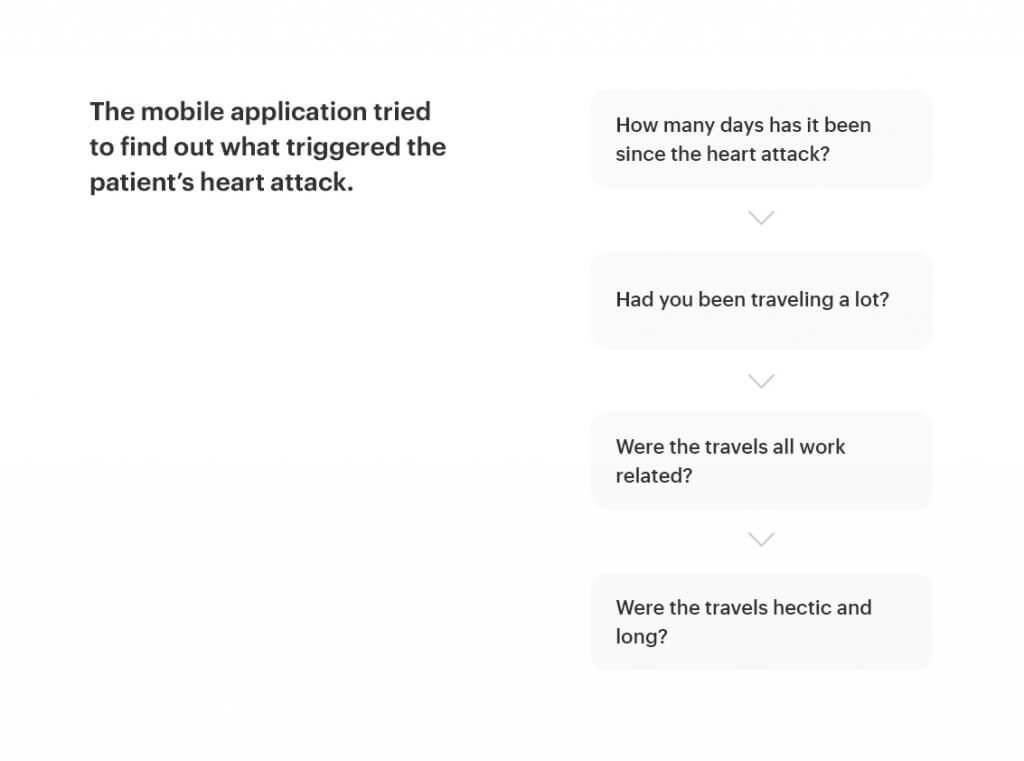
User Interview Tools
User Interviews can be a long process if not done smartly. We live in a time where mobile applications have made our lives a thousand percent easier. Thus every step of the interview can be made super quick and easy by a plethora of options already available in the play store. Below are listed the different kinds of applications for different phases of the interview process.
- Dedicated scheduling tools- Calendly, Doodle, YouCanBookMe
- Video conferencing tools- Zoom, Google Meet, Skype, BlueJeans, GoToMeeting
- Note-taking tools- ConfirmKit, Ever Note, Pear Note.
- Transcription tools- Rev, Reduct, Trint
- Survey tools- Survey Monkey, SurveyGizmo, Google Forms, Typeforms, Survicates, YesInsights, Google Surveys, Survey Legends
- Usability testing tools- LookBack, PingPong, UserTesting, Validately, Loop11, Userbrain, Userlytics, UsabilityHub, UserZoom, FocusVision, Qualtrics,
- Specialized testing tools- Dscout, Optimal Workshop.
- A/B testing tools- Optimizely, VWO
- Automated feedback tools- Appcues, Usabilla
- Heat Mapping tools- Hotjar, CrazyEgg, FullStory
- Analytics tools- Google Analytics, Heat Analytics, Kissmetrics, Mixpanel
- Research Ops and insights- dovetail, productboard, UserVoice, notion, Airtable, Trello
- Tools for the field- pen and paper, sticky notes, voice recorders, screen recorders, 360 camera.
User interview analysis
For the analysis to be successful, it is essential to take notes effectively and generously. The primary analysis takes places in three consecutive steps:
Familiarizing with the data
As the name suggests, this means getting to the data, reading the notes carefully, and understanding it. This phase becomes if more than one team member is involved in the process and participates in taking notes.
Synthesizing the data
To synthesize the data, four techniques can be used. These are:
- Structure data into themes
- Cluster related evidence
- Use segmentation
- Analyze across themes
Converting the findings into the desirable output
This is the final step, where the findings are converted into useful outputs. The reason for this is significant because:
- Conveying the insights efficiently to the stakeholders.
- It puts the thoughts and findings into the workable mode.
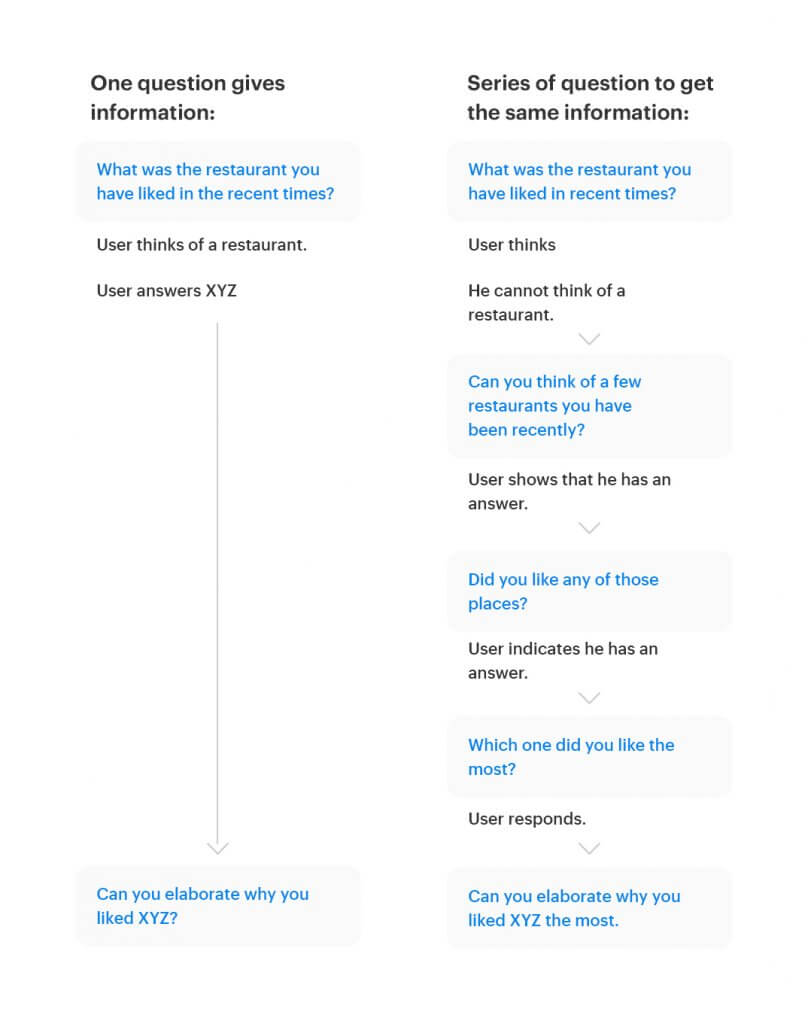
Benefits of User Interviews:
User interviews thus can be a very helpful and effective method of reading the minds of the customer. Trying to understand what the user feels not only gives us an idea about how well the application is working but also helps:
- To understand why the user selected the particular product, thus improving the future marketing strategies.
- To identify information gaps.
- Help to prioritize new features or changes in the website.
- Creating a stronger bond between the company and the customer.
FAQ: User Interviews
- Why is a user interview important?
User interviews are important because it helps to understand the user’s feelings towards a product or a service. Understanding the point of view of the user helps in improving the product.
2. When should interviews be used?
Interviews can be used as an alternative for written surveys. It can also be used when there is a need for a discussion.
3. What are in-depth interviews?
In-depth interviews is a research method which includes a small number of interviewees to understand their idea on a particular topic.
4. How do you conduct user study?
To conduct the user study first we have to understand the objective of the research then deciding on the interviewee after which we have to design the Interview Guide. After the Guide has been designed we take the interview and finally we summarize.
5. How do you conduct user testing?
User testing is usually conducted by designing the prototype, designing the test plan, understanding and getting the target users, finding a proper location and conducting the test. After the test has been conducted documenting the result is the final step.
6. How many user interviews should you do?
According to Nielsen Norman Group, usually 5 interviews are enough.


